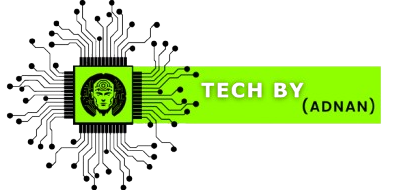Have you ever found yourself admiring a celebrity’s new haircut, only to try it yourself and be… underwhelmed? Or perhaps you’ve spent hours trying on different pairs of glasses, feeling like none of them quite “fit” your face? This is where a face shape analyzer comes in. It’s not about fitting into a specific mold, but rather about understanding your own beautiful, unique features so you can highlight them in the best possible way.
In this guide, we’ll take a deep dive into the world of face shape analysis. We’ll explore everything from the seven core face shapes to different methods for discovering your own, including a fantastic online tool that does the work for you. So, if you’re ready to unlock a new level of style and confidence, let’s get started!
Part 1: The “What” and “Why” of Face Shape Analysis
What is a Face Shape Analyzer and Why Does It Matter?
At its core, a face shape analyzer is a tool or method designed to help you identify the specific shape of your face. This is typically done by analyzing the proportions and contours of your face, including your forehead, cheekbones, jawline, and the overall length and width of your face.
But why is this so important? Think of it this way: your face is a canvas, and understanding its shape is like knowing the dimensions and features of that canvas. Once you have this knowledge, you can make informed decisions about how to “decorate” it. Here’s why it matters:
- Empowered Style Choices: No more guessing games! Knowing your face shape allows you to choose hairstyles, glasses, and even jewelry that will naturally complement your features.
- Time and Money Saver: By narrowing down your options, you’ll save time and money by avoiding styles that are unlikely to suit you.
- Boosted Confidence: When you know you look your best, you feel your best. Understanding your face shape can give you a major confidence boost.
- Enhanced Natural Beauty: The goal is not to change your face shape, but to enhance the beauty that’s already there. The right styles can soften certain features, highlight others, and create a more balanced and harmonious look.
The 7 Core Face Shapes: A Visual Introduction
While every face is unique, most can be categorized into one of seven core shapes. Here’s a quick overview:
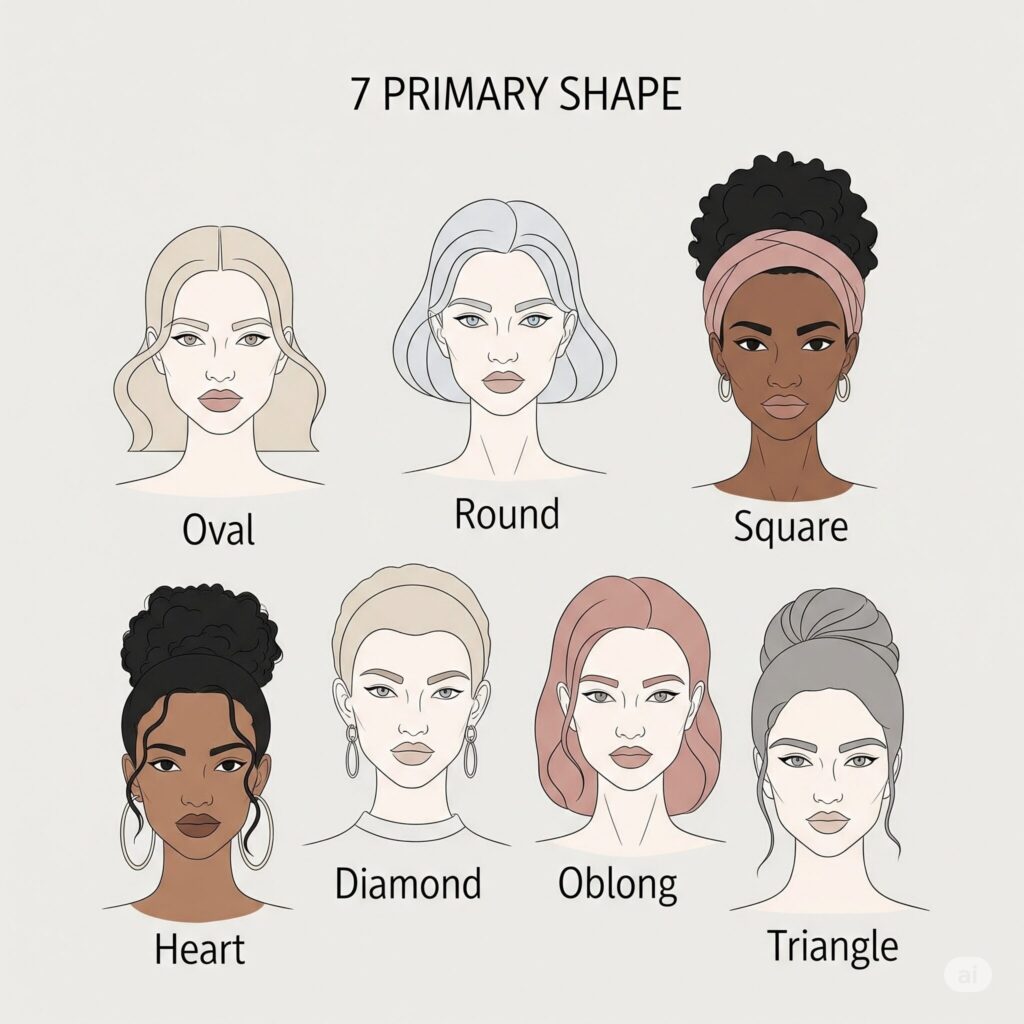
- Oval: Considered the “ideal” face shape due to its balanced proportions. The face is longer than it is wide, with a gently rounded jawline and forehead.
- Round: Characterized by a circular shape, with the width and length of the face being roughly equal. Full cheeks and a gently curved jawline are common features.
- Square: A strong, angular face shape with a broad forehead and a prominent, square jawline. The width of the forehead, cheekbones, and jaw are all very similar.
- Heart: This face shape is wider at the forehead and gradually narrows down to a pointed chin. It often comes with a widow’s peak hairline.
- Diamond: Similar to the heart shape, but with narrower forehead. The cheekbones are the widest part of the face, with a narrow forehead and chin.
- Oblong (or Rectangular): Longer than it is wide, with a square jawline and a high forehead. The sides of the face are typically straight.
- Triangle (or Pear): The opposite of the heart shape, the triangle face shape is characterized by a narrow forehead and a wide, prominent jawline.
Part 2: Find Your Face Shape: Three Proven Methods
Ready to discover your face shape? Here are three easy and effective methods you can try right now:
Method 1: The Instant AI Face Shape Analyzer
In today’s digital age, finding your face shape is easier than ever, thanks to AI-powered tools. These tools use sophisticated algorithms to analyze a photo of your face and provide you with an instant and accurate analysis.
One of the best tools out there is the Face Shape Analyzer from https://recognizereality.com/face-shape-analyzer/ This user-friendly tool allows you to upload a photo of yourself and receive a detailed analysis of your face shape, along with personalized recommendations for hairstyles, glasses, and more. It’s fast, easy, and a great way to get started on your journey to a more personalized style.
Method 2: The DIY Measurement Guide
If you prefer a more hands-on approach, you can easily determine your face shape with a few simple measurements. All you’ll need is a flexible measuring tape and a piece of paper to jot down your numbers.
- Forehead Width: Measure the widest part of your forehead, from one side of your hairline to the other.
- Cheekbone Width: Find the most prominent part of your cheekbones and measure the distance from one to the other.
- Jawline Width: Measure from the tip of your chin to the point below your ear where your jaw angles upward. Multiply the result by 2 to determine your full jawline length.
- Face Length: Measure from the center of your hairline to the tip of your chin.
Once you have these measurements, compare them to determine the widest part of your face and the overall shape. For example, if your face is as wide as it is long, you likely have a round or square face. If it’s longer than it is wide, you might have an oval or oblong face.
Method 3: The Quick & Easy Face Shape Quiz
Don’t have a measuring tape on hand? No problem! You can get a good idea of your face shape by simply answering a few questions about your features.
- What is the widest part of your face? (Forehead, cheekbones, or jaw)
- What is the shape of your jaw? (Round, square, or pointed)
- How long is your face? (Short, average, or long)
- Is your hairline straight or rounded?
- Do you have a widow’s peak?
Based on your answers, you can get a pretty accurate idea of your face shape.
Part 3: The Ultimate Style Guide for Your Face Shape
Now that you’ve discovered your face shape, it’s time for the fun part: learning how to style it! Here are some expert tips for hairstyles, glasses, and makeup for each of the seven core face shapes.
Hairstyles That Flatter: From Pixie Cuts to Long Locks
- For the Oval Face: Lucky you! With your balanced proportions, you can pull off almost any hairstyle. From short bobs to long, flowing layers, the world is your oyster.
- For the Round Face: The goal is to create the illusion of length and angles. Opt for hairstyles with height and volume on top, such as a high ponytail or a layered pixie cut. Side-swept bangs can also help to break up the roundness of your face.
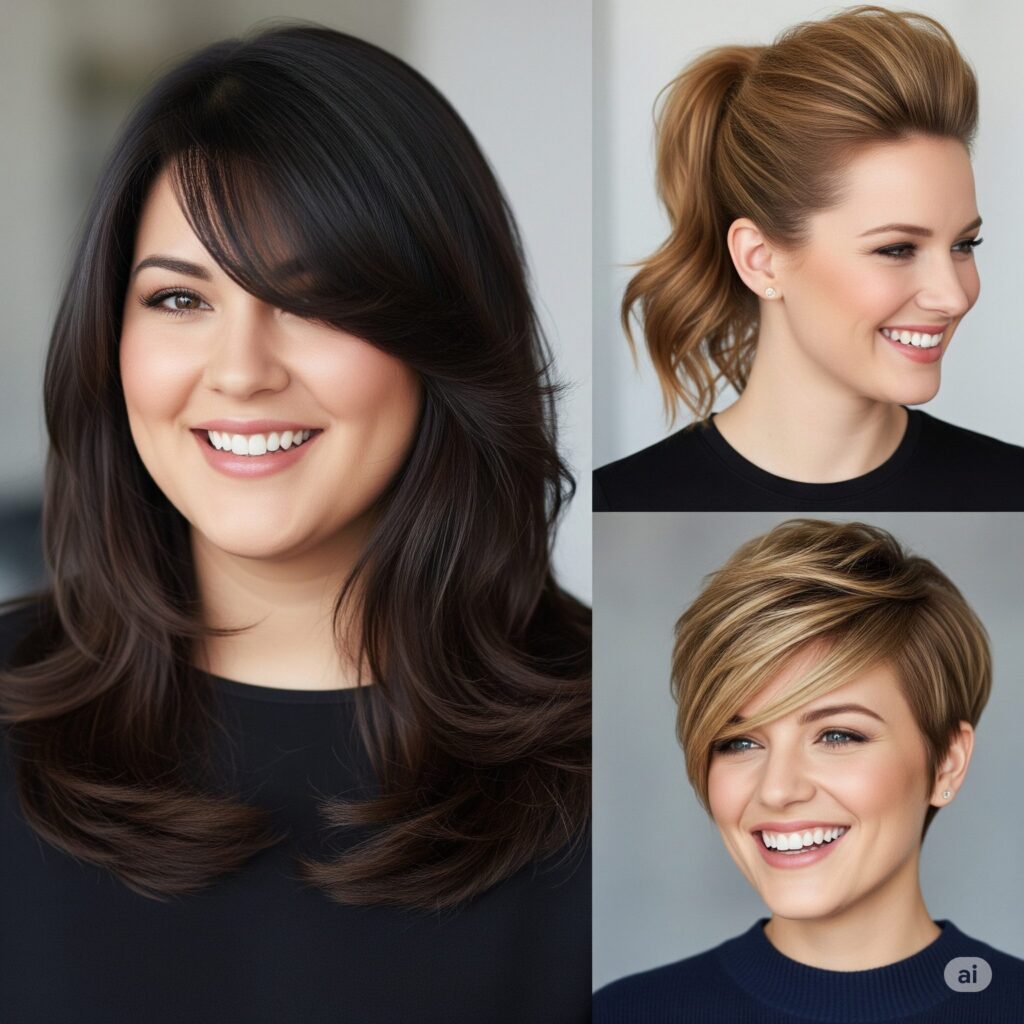
- For the Square Face: To soften your strong, angular features, go for hairstyles with soft waves or curls. Long bobs and layered styles can also help to add some roundness to your face.
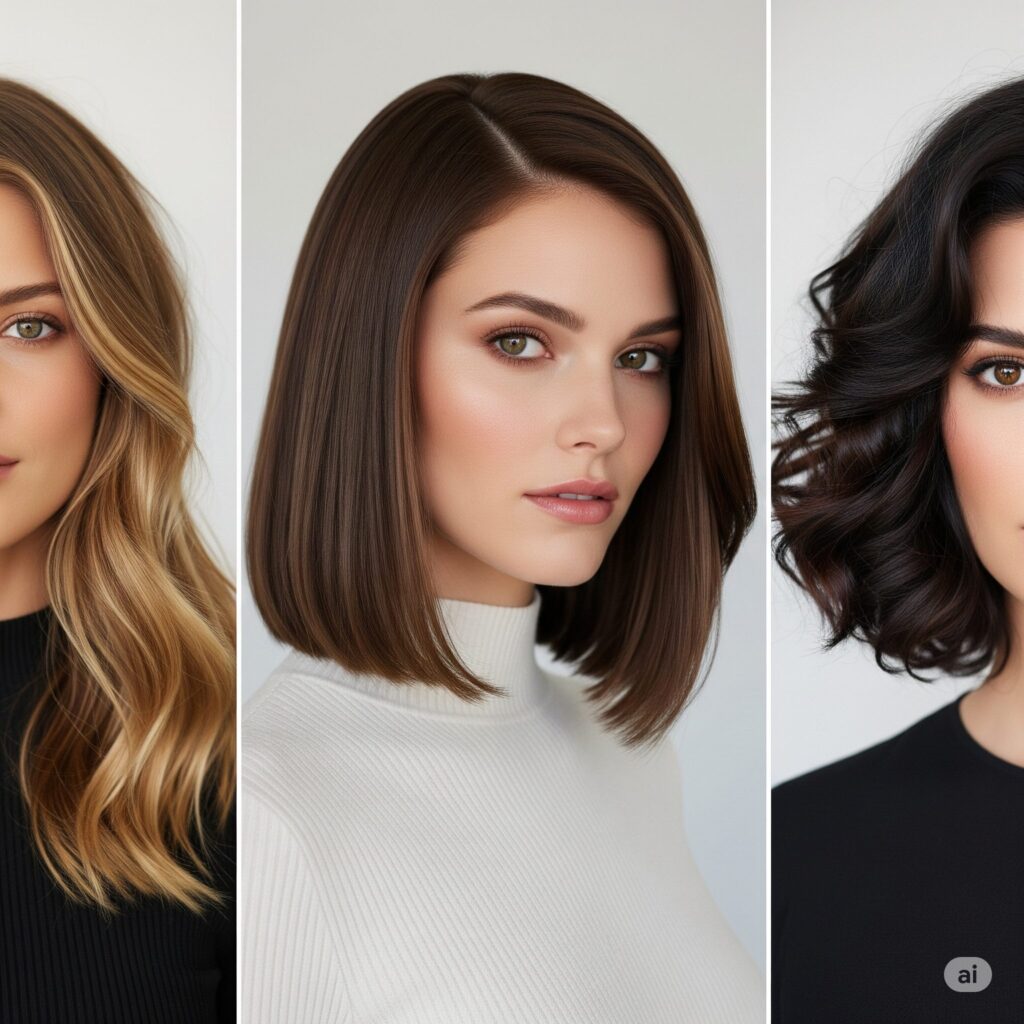
- For the Heart Face: To balance out a wider forehead and a narrower chin, choose hairstyles with volume at the bottom, such as a shoulder-length cut with layers or a side-parted bob.
- For the Diamond Face: Your goal is to soften your angular features and add some width to your forehead and chin. A chin-length bob or a hairstyle with soft, wispy bangs can work wonders.
- For the Oblong Face: To create the illusion of a wider face, go for hairstyles with volume on the sides, such as a layered cut or a curly bob. Blunt bangs can also help to shorten the appearance of your face.
- For the Triangle Face: To balance out a wider jawline, choose hairstyles with volume at the top, such as a layered pixie cut or a style with a deep side part.
The Perfect Frames: Choosing Glasses for Your Face Shape
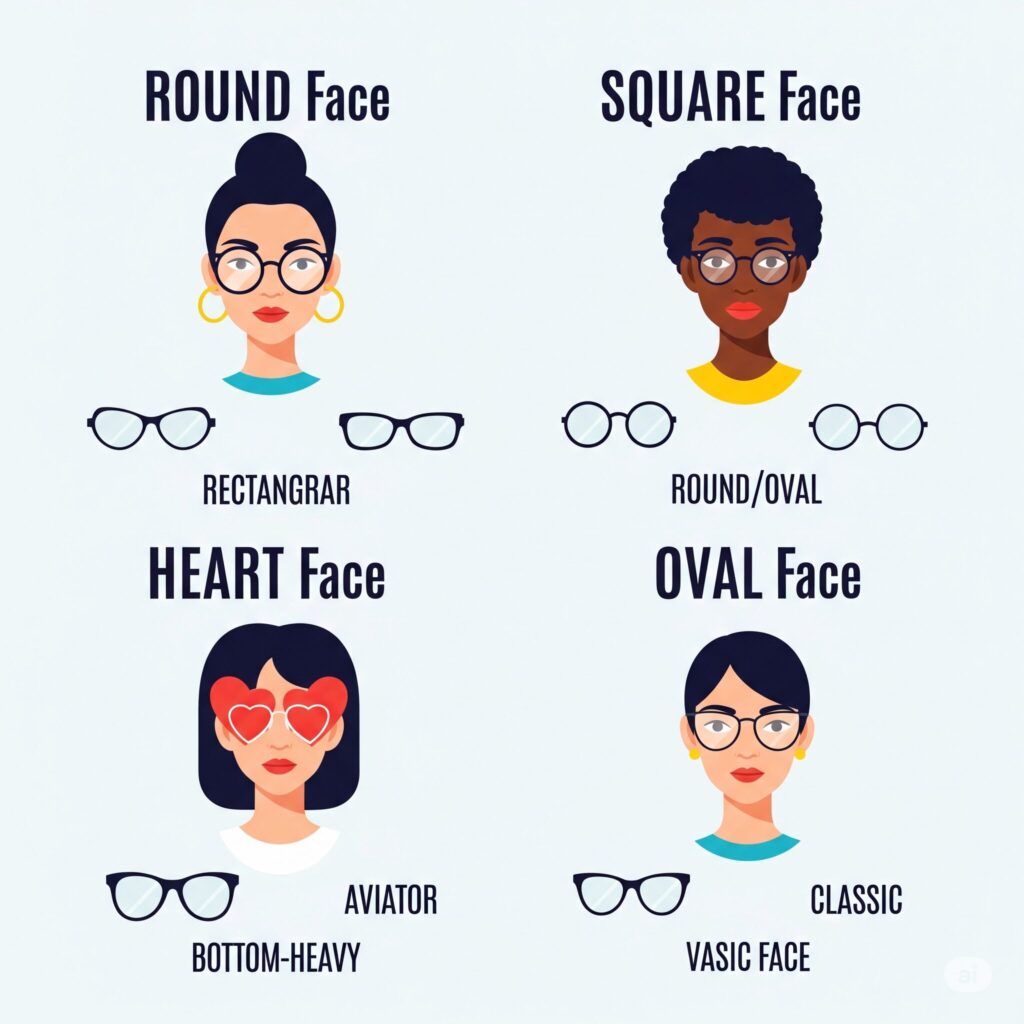
- For the Oval Face: Most frame shapes will suit you, but be careful not to choose frames that are too wide, as they can disrupt the natural balance of your face.
- For the Round Face: To add some definition to your face, choose angular frames, such as rectangular or square shapes. Avoid round frames, as they can make your face look even rounder.
- For the Square Face: To soften your angular features, go for round or oval frames. Cat-eye frames can also help to draw attention upward and away from your strong jawline.
- For the Heart Face: To balance out a wider forehead, choose frames that are wider at the bottom, such as aviator or bottom-heavy styles.
- For the Diamond Face: To highlight your cheekbones and soften your angular features, choose frames that are wider than your cheekbones, such as cat-eye or oval shapes.
- For the Oblong Face: To create the illusion of a wider face, choose frames that have more depth than width, such as square or decorative styles.
- For the Triangle Face: To add some width to your narrow forehead, choose frames that are wider at the top, such as cat-eye or browline styles.
Makeup Magic: Contouring and Highlighting for Your Features
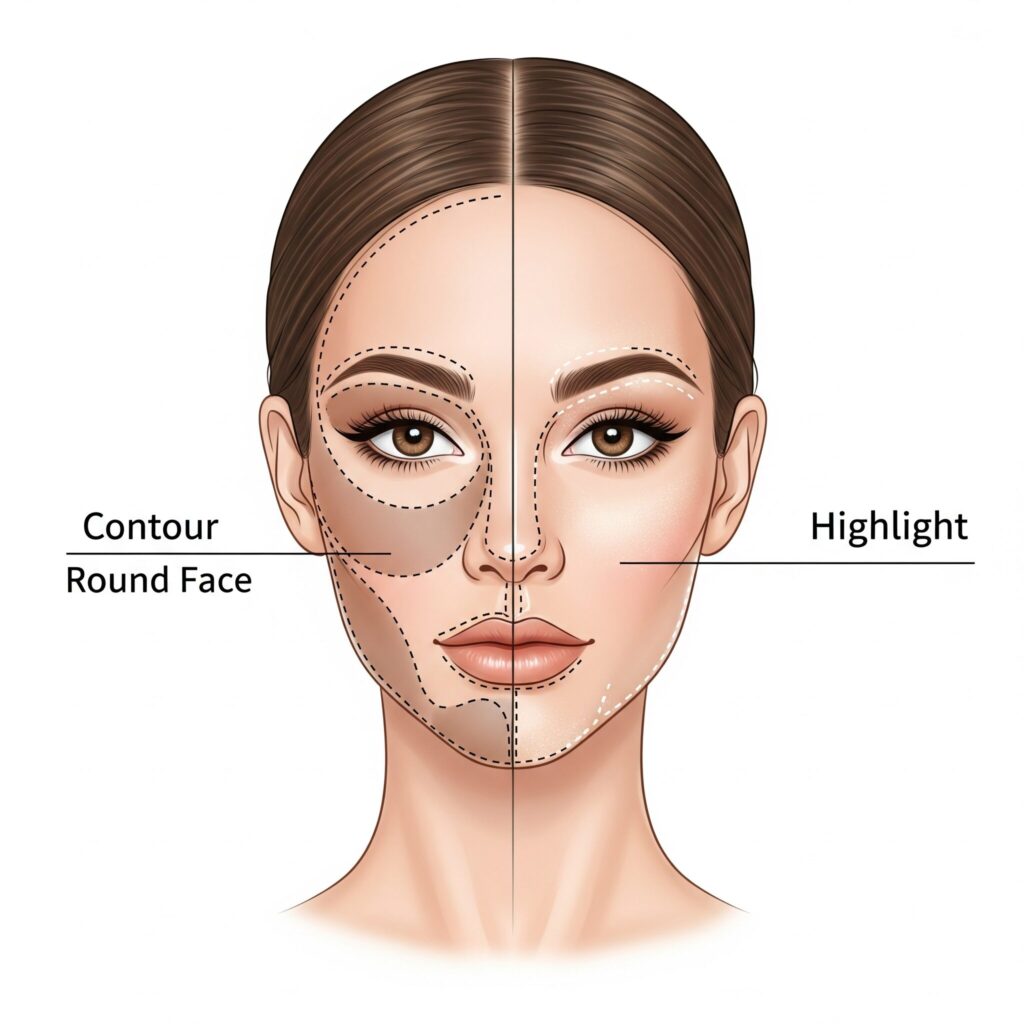
- For the Oval Face: With your balanced features, you don’t need to do much contouring. Simply apply a bit of highlighter to the high points of your face (cheekbones, brow bone, and the bridge of your nose) to enhance your natural glow.
- For the Round Face: To create the illusion of a more angular face, apply a matte bronzer to the hollows of your cheeks, your temples, and along your jawline. Apply highlighter to the center of your forehead and chin to draw attention to the length of your face.
- For the Square Face: To soften your angular features, apply bronzer to the corners of your forehead and jawline. Apply highlighter to your cheekbones and the center of your forehead to create some roundness.
- For the Heart Face: To balance out a wider forehead, apply bronzer to your temples and the sides of your forehead. Apply highlighter to your chin to add some width to the lower part of your face.
- For the Diamond Face: To soften your angular features, apply bronzer to your cheekbones and the tip of your chin. Apply highlighter to the center of your forehead and chin to create a more balanced look.
- For the Oblong Face: To create the illusion of a wider face, apply bronzer to your hairline and along your jawline. Apply highlighter to your cheeks to add some width.
- For the Triangle Face: To balance out a wider jawline, apply bronzer to your jawline and the sides of your chin. Sweep a bit of highlighter across your forehead to create the illusion of a wider upper face.
Beyond the Face: Necklines and Earrings to Complete Your Look
Did you know that the right neckline and earrings can also help to flatter your face shape?
- For a Round Face: V-necks and scoop necks can help to elongate your face, while long, dangly earrings can add some length.
- For a Square Face: Round or oval necklines can help to soften your angular features, while hoop or drop earrings can add some curves.
- For a Heart Face: Sweetheart or scoop necklines can help to balance out a wider forehead, while teardrop or chandelier earrings can add some width to your chin.
Part 4: Deeper Dive into Facial Aesthetics
For those who are curious to learn more, let’s explore some of the science behind facial beauty.
The Science of Beauty: Understanding Facial Symmetry and the Golden Ratio
Have you ever wondered why some faces are considered more “beautiful” than others? While beauty is subjective, research has shown that there are certain facial characteristics that are universally perceived as attractive. Two of the most well-known concepts are facial symmetry and the golden ratio.
- Facial Symmetry: This refers to how similar the two sides of your face are. Studies have shown that people with more symmetrical faces are often perceived as more attractive.
- The Golden Ratio: This is a mathematical ratio that is found throughout nature, and it’s also been applied to human faces. It’s believed that faces that are closer to the golden ratio are more aesthetically pleasing.
While it’s interesting to learn about these concepts, it’s important to remember that they are not the be-all and end-all of beauty. True beauty comes from within, and confidence is the most attractive thing a person can wear.
Conclusion on Face Shape Analyzer
Discovering your face shape is like unlocking a secret style weapon. It’s a simple yet powerful piece of knowledge that can transform the way you approach your personal style. By understanding your unique features, you can make choices that not only flatter your face but also boost your confidence and allow your natural beauty to shine through.
We hope this guide has been helpful on your journey to discovering your face shape. Remember, this is not about fitting into a box, but about celebrating your individuality. So go ahead, experiment with different styles, have fun, and embrace the beautiful, unique person that you are!
Frequently Asked Questions (FAQ)
Can my face shape change over time?
Yes, your face shape can change due to factors such as weight gain or loss, aging, and even dental work.
What is the most common face shape?
The oval face shape is considered the most common.
Do I have to stick to these style rules?
Not at all! These are just guidelines to help you understand what might flatter your features. The most important thing is to choose styles that make you feel happy and confident.
Are these face shape analyzers accurate?
AI-powered tools like the one on https://recognizereality.com are generally very accurate, but it’s always a good idea to use them as a starting point and then experiment to see what works best for you.
What’s the difference between a heart-shaped and a triangle-shaped face?
They are opposites. A heart-shaped face is wider at the forehead and narrower at the chin, while a triangle-shaped face is narrower at the forehead and wider at the jawline.
READ MORE ARTICLES
How to Factory Reset, Restart & Reboot Your ASUS Laptop [2025]
The Ultimate Guide: How to Optimize Your Gaming PC for RT
Fix ‘Undoing Changes’ Loop: Step-by-Step PC Repair Guide
How to Optimize Gaming Laptop for VR: Complete 2025 Guide
How to Save Outlook Email as PDF: Complete Guide (With Attachments) 2025
